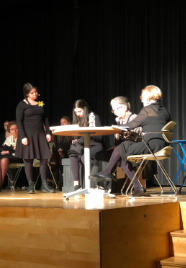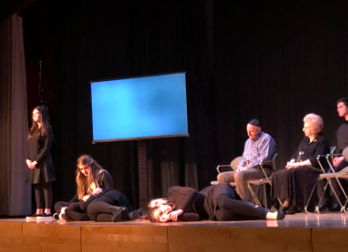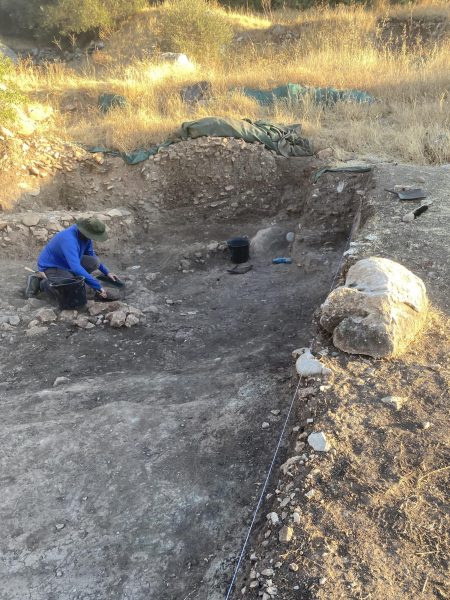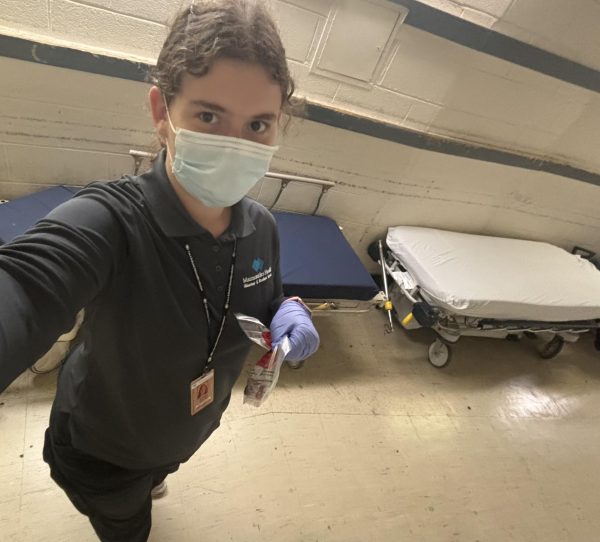One Heartbeat: My Experience in Witness Theater
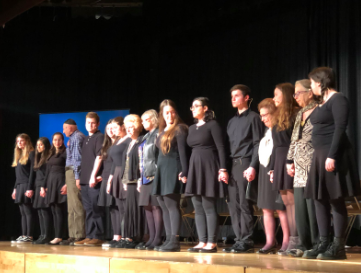
A heartbeat. A constant, single beat that keeps you alive. It stops, you stop. Your life depends on it.
Over this academic year, I participated in Witness Theater. Every week, seven Holocaust survivors shared their stories with eleven high school students. Hand in hand, they passed their experiences to us and shared their heartbeat with us. Together, we squeezed hands and created a communal heartbeat. A sign of love, not hate. A sign of community, not isolation.
Witness Theater partners Holocaust survivors with Jewish high school students and creates a community in which the survivors share their stories with the students. At Ramaz, Witness Theater, a program run by Selfhelp, is led by Ramaz English teacher Ms. Susan Litwack together with Selfhelp’s drama therapist Andrea Stefens, program director Eve Udesky, and social worker Emily Prawer. Under their guidance, the survivors’ stories become a script that allows the students to understand and retell their experiences. On Yom HaShoah, the students, together with the survivors, put on a dramatic enactment of their experiences.
My great-grandparents were survivors. Most of their families were murdered. They died before I was born, so I would never hear their stories firsthand or see how the war affected the lives of people I love. In my life, the Holocaust always has been present, whether meeting Holocaust survivors, touring Holocaust museums around the world, or my family’s involvement in Holocaust programs and organizations. I joined Witness Theater to understand my family’s history and what the big number—six million—really means.
In September, the survivors and the students were strangers. We began by eating dinner together and having conversations about our weekends with friends, busy test schedules, and vacations. They told us about grandchildren taking ballet lessons, visits to the opera, and their lunch dates with friends. Over time, the conversations did not feel like part of a program; these were moments with a friend, to which I looked forward.
After dinner, the formal session began by “saying hello with our eyes.” We would walk around the room and smile at each other with our eyes. We spent time getting to know each other: playing icebreaker games, asking questions of each other, and finding similarities with each other. The goal of these icebreakers and the dinners was to synchronize our heartbeats.
After several weeks, the survivors started to share their stories. We heard about different chapters of their lives: “My Life Before the War”, “When the War First Affected My Life”, “My Life During the War”, and “My Life After the War”. It was not a history textbook; rather it was how the war forever changed the lives of people I now knew and care about.
The students sat one-on-one with a survivor. Then, the students would share the story with the rest of the group. Fay told us how she was poisoned to make her stop crying, so she would not give away all the people in hiding. She told us it was a “choiceless choice” and how she never spoke to her mother about that moment, but forgave her. Greta told us about watching her mother sew the yellow stars with the word “Juif,” Jew, on her family’s coats. She watched tears run down her mother’s petrified face. Margot told us about the pain of marching on foot, so bad that she was ready to give up. She told us that the Gunskirchen camp was “hell on earth.” Even though it was so hard for Margot to verbalize the nightmares that had happened to her, she did it for us.
We also heard about some of the best parts of their lives. We heard how they survived the horrors of the Holocaust and rebuilt their lives. Fay excitedly shows us pictures of her granddaughters each week. Margot, a retired chemist, talks about her grandchildren with the biggest smile. Robert talks about his life-partner, Jimmy, with love. Francoise passionately voices her opinions on current events. Greta cares for her husband. Johanna enjoys dates with her friends. Eva constantly reminds us to love everyone and appreciate what we have.
I have heard many Holocaust survivors speak, in large group or even in my home, but sitting together with these survivors who shared their memories with us, sometimes through tears of pain, was something different. I felt obligated to carry and share their stories. I felt the need to write everything down and take it with me. I did not want to forget a single detail.
After a survivor shared a story, we posed to represent how the survivors and we felt. We expressed love, loss, freedom, fear, and continuity. We turned emotions into physical poses that we could take with us and remember. Emotions which we could never forget.
After months of work, Andrea took the stories and converted them into a beautiful script. I have never been in a play before, and I worked hard to understand how each person I played would feel.
Our first performance was on Yom HaShoah for Congregation Kehilath Jeshurun. With my mother and brothers, I lit a candle in memory of the family members I never met. As I listened to Kel Maleh Rachamim, a prayer for the six million men, women, and children who were shot, gased, and burned, I closed my eyes and tried to picture what these seven survivors were feeling, what it meant for them to come and relive the worst moments of their lives on stage.
During the performances, I had experiences I had never had before: I sewed yellow stars onto my family’s coats; I left my daughter at a monastery, never knowing if I would see her again; I found out my husband died and had to keep living, even in the ghetto; I witnessed corpses piled up in the camps. I only felt a small piece of the pain and horror the survivors felt.
During the performance, at the end of each survivor’s story, they read a statement about their message to the next generation. They expressed gratitude for their lives and a powerful desire to survive and perpetuate the memories of those they lost. I had heard these statements during the practices, but at the actual performances, my eyes welled with tears. I am in awe of everything they have achieved. How they did not give up, they did not stop living, they persisted.
Days after a terrorist attack in a Chabad Synagogue in San Diego, I wondered: what if I am stopped at every corner and asked for a Jewish identity card? What if I one day have to wear a yellow star? What if I will have to hide in a pigsty because I am Jewish?
Hate and antisemitism filled Europe in the 1930s and 40s. It still exists today. That is why Witness Theater is needed. It is about understanding what evil can do when people stop seeing others as humans. It is not about being scared to live your life. It is about being thankful. It is about remembering the individuals and personalities who were killed and preventing it from ever happening again.
A week later, on Yom Ha’Azmaut, sitting in davening at Ramaz, I thought about what Israel meant to me and to the survivors. One week earlier, we had worn yellow stars, a marker enforced on Jews in Europe to isolate them. Now, we were wearing blue and white stars, a sign of our homeland, the State of Israel, with pride. We were dancing on the street of New York City, singing and waving flags with. I could never imagine how emotional Yom Ha’Azmaut in 1948 was for the survivors. Three years earlier they were homeless, living in ghettos and concentration camps, and now they had a home. We have a home. Right before the last performance, Margot turned to me and said, “We are so blessed to have Israel.” I did not fully appreciate what she was saying until I was wearing blue and white, singing Hallel, and thanking God for the gift of Israel.
When the Jews left Egypt, their “hell on earth”, they were each escaping different emotional, physical, and spiritual nightmares. But, when the nation came together to receive the Torah at Har Sinai, they were, according to Rashi, “like one person with one heart.” They were all united and all promised to accept and love God together.
The performances each started and ended with the students and the survivors standing in a line with our heads held high, proud to be Jews. We held each other up and squeezed one another’s hands, our heartbeat. The Heartbeat of the Group was more than a closing, it was a promise. I promise that I will keep in my heartbeat the stories, the horrors, the memories, the messages, the legacy. But moreover, I promise that I will repeat them. I will share them. I will spread the heartbeat.
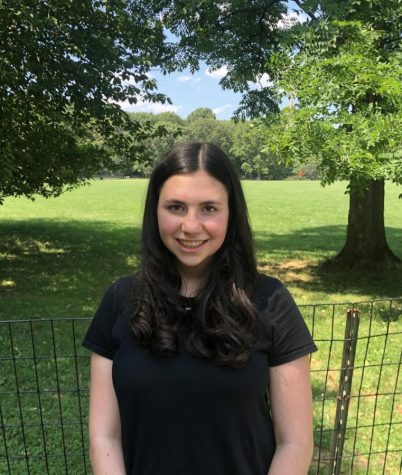
Rebecca Massel has been a journalist since lower school and is excited to be an editor-in-chief of The Rampage. She has been an active writer for the paper...

